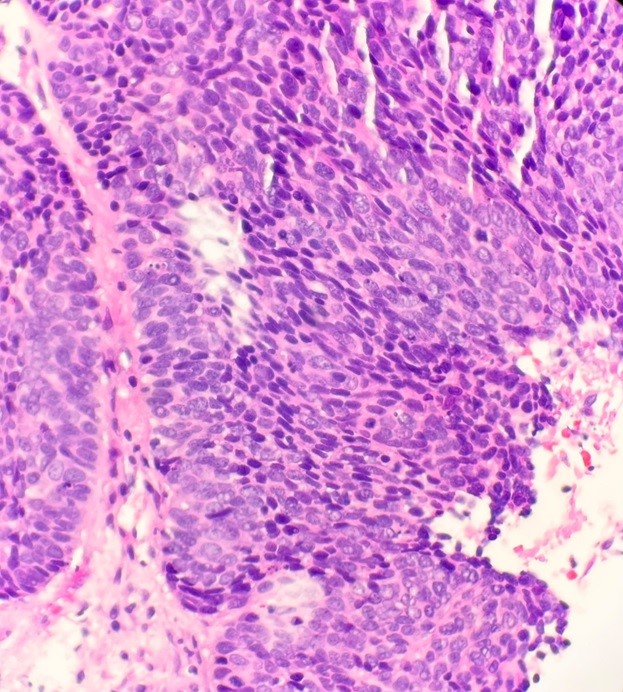Back
Poster Session E - Tuesday Afternoon
E0123 - An Atypical Case of Squamous Cell Carcinoma of the Rectum Masquerading as a Rectal Carcinoid Tumor
Tuesday, October 25, 2022
3:00 PM – 5:00 PM ET
Location: Crown Ballroom

Jamil M. Shah, MD
The Brooklyn Hospital Center
Brooklyn, NY
Presenting Author(s)
Jamil M. Shah, MD, Pratyusha Tirumanisetty, MD, Eric Then, MD, Vikash Kumar, MD, Philip Xiao, MD, Madhavi Reddy, MD, Denzil Etienne, MD, Derrick Cheung, MD
The Brooklyn Hospital Center, Brooklyn, NY
Introduction: Squamous cell carcinoma (SCC) of the GI tract is rare. When encountered, it usually involves the esophagus or the anal canal. Infrequently, it can be associated with a fistula of the GI tract, lined by squamous mucosa. SCC of the rectum is very unusual and not much is known about its pathogenesis, prognosis, and optimal treatment.
Case Description/Methods: A 67 y/o M, with PMH of HIV, CKD stage 3, and HLD, initially presented with intermittent hematochezia for a few months, along with mucus per rectum and lower abdominal pain. He denied constipation, weight loss, and other GI symptoms. He underwent colonoscopy in 8/2021, which demonstrated left colon diverticulosis, a 6 mm tubular adenoma in the sigmoid, and a 10 mm rectal submucosal nodule at 10 cm proximal to the anus. It was biopsied and came back as hyperplastic changes. He was referred for rectal EUS for further evaluation of the rectal nodule. He underwent flexible sigmoidoscopy and lower EUS-FNB in 11/2021 with finding of a 33.3x24.8 mm rectal submucosal lesion arising from the muscularis propria. Pathology initially demonstrated high grade squamous intraepithelial lesion (HGSIL) and the diagnosis of malignancy was not confirmed. However, the pathology was sent to a reputable cancer center for a second opinion and confirmed a diagnosis of SCC (Fig 1). He continued to have intermittent rectal bleeding and mucus in the stools, prompting him to visit the ER for further evaluation. A CT scan demonstrated no acute findings, and he was discharged. A repeat CT scan would demonstrate a 3.3x2.9x2.4 cm soft tissue mass arising from the low rectum at the 3-7 o'clock position, highly concerning for neoplasm. He obtained a second opinion from a colorectal surgeon who performed a third transanal procedure. The biopsy results of the rectal mass demonstrated rectal cancer again, per patient. He has been started on neoadjuvant chemotherapy and radiation therapy.
Discussion: SCC is among the rarest forms of rectal cancer. 90% are adenocarcinomas, while the remaining 10% is comprised of carcinoid tumors, lymphomas, and GISTs. While SCC can occur throughout the GI tract, it usually affects the esophagus or the anal canal. This lesion presented as a suspected rectal carcinoid tumor, located far from the anal verge. Pure SCC of the rectum remains an extremely rare histological diagnosis and clinical occurrence. Further research is needed about its pathogenesis, prognosis, and optimal treatment.

Disclosures:
Jamil M. Shah, MD, Pratyusha Tirumanisetty, MD, Eric Then, MD, Vikash Kumar, MD, Philip Xiao, MD, Madhavi Reddy, MD, Denzil Etienne, MD, Derrick Cheung, MD. E0123 - An Atypical Case of Squamous Cell Carcinoma of the Rectum Masquerading as a Rectal Carcinoid Tumor, ACG 2022 Annual Scientific Meeting Abstracts. Charlotte, NC: American College of Gastroenterology.
The Brooklyn Hospital Center, Brooklyn, NY
Introduction: Squamous cell carcinoma (SCC) of the GI tract is rare. When encountered, it usually involves the esophagus or the anal canal. Infrequently, it can be associated with a fistula of the GI tract, lined by squamous mucosa. SCC of the rectum is very unusual and not much is known about its pathogenesis, prognosis, and optimal treatment.
Case Description/Methods: A 67 y/o M, with PMH of HIV, CKD stage 3, and HLD, initially presented with intermittent hematochezia for a few months, along with mucus per rectum and lower abdominal pain. He denied constipation, weight loss, and other GI symptoms. He underwent colonoscopy in 8/2021, which demonstrated left colon diverticulosis, a 6 mm tubular adenoma in the sigmoid, and a 10 mm rectal submucosal nodule at 10 cm proximal to the anus. It was biopsied and came back as hyperplastic changes. He was referred for rectal EUS for further evaluation of the rectal nodule. He underwent flexible sigmoidoscopy and lower EUS-FNB in 11/2021 with finding of a 33.3x24.8 mm rectal submucosal lesion arising from the muscularis propria. Pathology initially demonstrated high grade squamous intraepithelial lesion (HGSIL) and the diagnosis of malignancy was not confirmed. However, the pathology was sent to a reputable cancer center for a second opinion and confirmed a diagnosis of SCC (Fig 1). He continued to have intermittent rectal bleeding and mucus in the stools, prompting him to visit the ER for further evaluation. A CT scan demonstrated no acute findings, and he was discharged. A repeat CT scan would demonstrate a 3.3x2.9x2.4 cm soft tissue mass arising from the low rectum at the 3-7 o'clock position, highly concerning for neoplasm. He obtained a second opinion from a colorectal surgeon who performed a third transanal procedure. The biopsy results of the rectal mass demonstrated rectal cancer again, per patient. He has been started on neoadjuvant chemotherapy and radiation therapy.
Discussion: SCC is among the rarest forms of rectal cancer. 90% are adenocarcinomas, while the remaining 10% is comprised of carcinoid tumors, lymphomas, and GISTs. While SCC can occur throughout the GI tract, it usually affects the esophagus or the anal canal. This lesion presented as a suspected rectal carcinoid tumor, located far from the anal verge. Pure SCC of the rectum remains an extremely rare histological diagnosis and clinical occurrence. Further research is needed about its pathogenesis, prognosis, and optimal treatment.

Figure: Squamous cell carcinoma with basaloid features.
Disclosures:
Jamil Shah indicated no relevant financial relationships.
Pratyusha Tirumanisetty indicated no relevant financial relationships.
Eric Then indicated no relevant financial relationships.
Vikash Kumar indicated no relevant financial relationships.
Philip Xiao indicated no relevant financial relationships.
Madhavi Reddy indicated no relevant financial relationships.
Denzil Etienne indicated no relevant financial relationships.
Derrick Cheung indicated no relevant financial relationships.
Jamil M. Shah, MD, Pratyusha Tirumanisetty, MD, Eric Then, MD, Vikash Kumar, MD, Philip Xiao, MD, Madhavi Reddy, MD, Denzil Etienne, MD, Derrick Cheung, MD. E0123 - An Atypical Case of Squamous Cell Carcinoma of the Rectum Masquerading as a Rectal Carcinoid Tumor, ACG 2022 Annual Scientific Meeting Abstracts. Charlotte, NC: American College of Gastroenterology.
